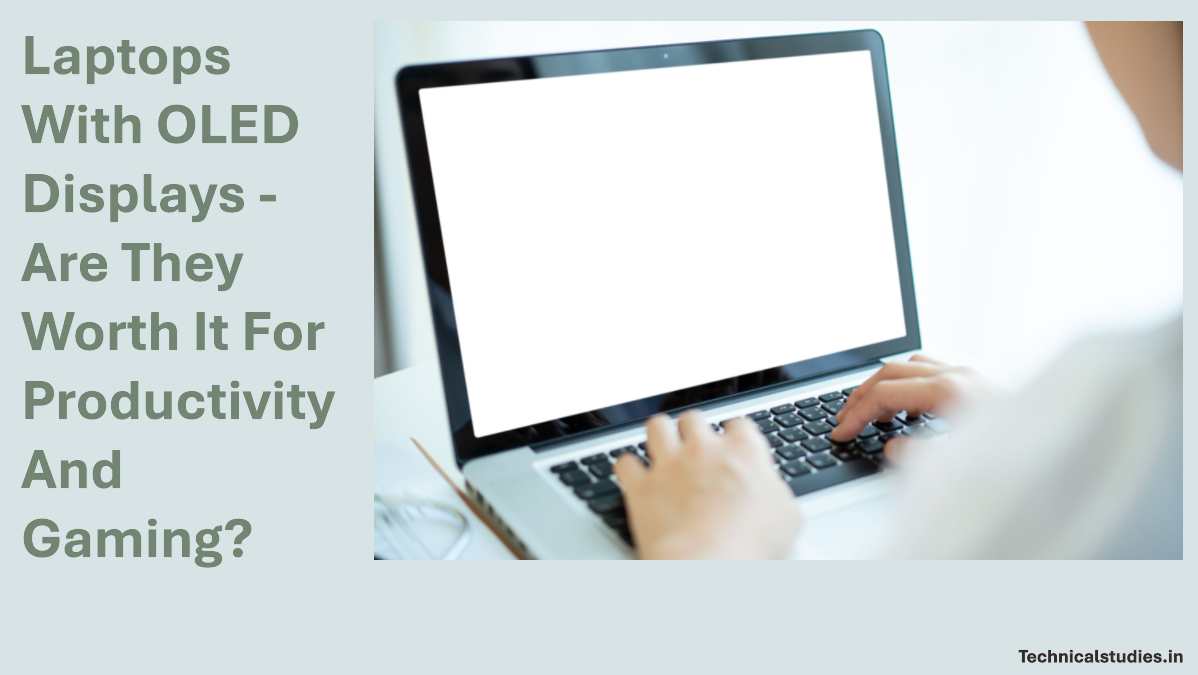OLED screens have emerged as a major player in the laptop market in recent years, offering breathtaking images and an excellent viewing experience. OLED (Organic Light Emitting Diode) technology was first made popular by smartphones and expensive televisions, but it has since spread to laptops in a variety of markets, from svelte ultrabooks to powerful gaming computers.
The allure is obvious: OLED screens have amazing contrast ratios, richer colors, deeper blacks, and quicker response times than conventional LCDs.
OLED laptops are therefore becoming more and more popular among professionals, gamers, and content producers for both work and play. OLED can change your experience whether you’re watching movies, editing pictures, creating graphics, or simply wanting bright images.
We’ll discuss whether OLED laptops are really worth the money in this post. We’ll analyze their performance in real-world scenarios, go over their benefits and drawbacks, and provide helpful advice to help you determine whether an OLED laptop is right for you, particularly if productivity or gaming are your main priorities.
What is OLED? Understanding the Technology
It is helpful to first understand how OLED technology differs from conventional LCDs in order to comprehend why OLED laptops are becoming more and more popular. Organic Light Emitting Diode is referred to as OLED.
Self-emissive pixels, which produce light from each individual pixel, are used in OLED displays as opposed to LCDs, which need a backlight to illuminate the screen. This basic distinction results in a number of observable enhancements in display quality.
An image is created on LCD panels by a continuous backlight shining through layers of liquid crystals and filters. This technique frequently produces less contrast and grayish blacks, particularly in darker images.
OLED pixels, on the other hand, have the ability to fully shut off when showing black, producing incredibly deep blacks and an infinite contrast ratio. Images appear more vibrant, impactful, and captivating as a result.
Color reproduction is yet another significant benefit. OLED screens are perfect for color-sensitive applications like picture editing and video grading since they usually have larger color gamuts and better color fidelity.
Because OLED pixels can change states more quickly than LCD pixels, gamers and media aficionados also enjoy smoother action and faster response times.
To put it briefly, OLED makes images come to life in a manner that LCD screens just cannot, which is why it’s quickly becoming a popular feature in contemporary computers.
OLED for Productivity: A Game-Changer or Gimmick?

For professionals who rely on visual precision—graphic designers, video editors, photographers—OLED displays can be a true game-changer. In addition to making creative work more pleasurable, the color accuracy, rich saturation, and deep blacks make it more dependable.
Many OLED laptops now cover 100% of the DCI-P3 color gamut and feature factory color calibration, which is a big bonus for anyone working in digital media or print.
But even if you don’t work in creative design, you may still see the advantages of OLED. White backgrounds are bright and pure, text seems sharp, and overall clarity can make working and reading more enjoyable.
This can lessen eye strain from extended work sessions, particularly when paired with the dark mode or lower blue light settings that many OLED displays offer.
There is a catch, though: burn-in. Taskbars, toolbars, and lines of code are examples of static components that can weakly stay on the screen over time when they are left there for extended periods of time.
Users who work with static UI-heavy apps like Excel, IDEs, or CRM dashboards are still concerned about OLED screens, even though their longevity has improved, and manufacturers frequently incorporate safeguards like pixel shifting or screen savers.
Fortunately, OLED-aware features like dynamic UI shifting, auto-dimming static regions, and dark mode defaults are now available in many laptops and operating systems to help lower the risk. OLED can provide a high-end productivity experience with few drawbacks if used carefully.
OLED for Gaming: Stunning Visuals with a Catch

Using an OLED laptop for gaming is simply amazing. In-game settings feel more realistic than ever thanks to the striking contrast, brilliant hues, and accurate blacks. When you’re racing in neon lights, exploring dimly lit dungeons, or watching dramatic sequences, OLED makes every frame come to life in a way that conventional screens can’t compare.
OLED’s blazingly quick response time is one of its main advantages for games. OLED pixels respond nearly instantly, resulting in smooth motion and less blur than LCD cells, which take milliseconds to change states.
This is especially helpful in fast-paced games like racing games or first-person shooters. When paired with HDR (High Dynamic Range) capability, OLED screens provide an unparalleled sense of realism and depth.
However, OLED laptops have drawbacks, particularly for gamers who compete. While some high-performance LCD gaming panels can reach 300Hz or more, high-end OLED panels are still lagging behind, even if they are beginning to provide refresh rates of 120Hz or even 240Hz.
Furthermore, ghosting and input latency are not usually problems, but every millisecond counts if you’re playing professionally.
Then there is the persistent worry of burn-in. Health bars, ammo counters, and minimaps are examples of static features found in many games that stay in one place for hours at a time. These may eventually lead to burn-in or image retention on OLED screens.
Although dynamic HUD choices and screen protection features are helping game developers and laptop manufacturers get around this, it’s still something to be wary of, particularly for extended gaming sessions.
OLED gaming laptops are better than ever in 2025, despite these compromises. These days, models like the Alienware x14 R2 and ASUS ROG Zephyrus G16 combine OLED brightness with powerful GPUs, high refresh rates, and efficient thermals.
As long as you play wisely and don’t leave static screens unattended for too long, the graphics alone are worth it for the majority of gamers.
OLED vs IPS Displays: Which One Should You Choose?
Most consumers compare OLED and IPS (In-Plane Switching) panels when selecting a laptop display. Although they serve somewhat varied requirements and tastes, each has advantages.
Contrast and Color
OLED is obviously superior in terms of contrast. OLED can provide true blacks and an infinite contrast ratio since each pixel generates its own light. Richer colors and sharper images are produced as a result, making them ideal for creative work or movie viewing.
Even while IPS screens don’t have as many black levels, they can nevertheless reproduce color and contrast well, especially when calibrated properly.
Brightness
IPS panels are generally brighter than OLEDs, which makes them ideal for use in bright spaces like well-lit offices or outdoor areas. Though many still fall a little short in terms of peak brightness, OLED displays are getting better in this area.
Response Time and Motion Handling
Once again, OLED is the best option if speed is important to you, such as when gaming or editing videos. Motion blur and ghosting are lessened by its almost immediate pixel responsiveness. Even though they are usually smooth, IPS screens fall short of OLED in this area.
Burn-in and Durability
The possibility of burn-in is one of OLED’s main drawbacks. If static elements, such as toolbars, HUDs, or browser tabs, are seen for an extended period of time, they may leave behind ghost images.
Because IPS panels don’t have this issue, they are more suited for coding or productivity apps where static material is frequently present.
Price
Because OLED laptops use more sophisticated display technology, they are usually more expensive.
In contrast, IPS versions are more reasonably priced and are available in a greater variety of devices, ranging from high-end ultrabooks to reasonably priced student laptops.
So, which should you choose?
- Go for OLED if you prioritize media consumption, creative work, or immersive gaming, and don’t mind being a bit cautious with screen usage.
- Choose IPS if you value long-term durability, spend a lot of time working with static applications, or need higher brightness and a lower price point.
Ultimately, it’s about how you use your laptop. OLED is premium, bold, and beautiful—but IPS remains practical, reliable, and versatile.
Battery Life on OLED Laptops

When purchasing a laptop, battery life is a crucial factor, and OLED panels add an intriguing dimension to this equation.
OLED screens illuminate each pixel separately, in contrast to IPS displays, which employ a continuous backlight regardless of what is on screen. This indicates that the image being displayed affects power usage.
OLED has the potential to be more energy-efficient in theory, particularly when displaying darker content. OLED uses significantly less power than a backlit IPS screen, particularly when working in a text editor with a black background, watching videos with predominantly dark scenes, or using dark mode.
For this reason, many OLED laptop users find that lowering screen brightness and embracing dark themes results in longer battery life.
But in reality, OLED battery life can also be negatively impacted, especially when dealing with bright, white-heavy content like spreadsheets, papers, or web pages.
Expect your battery to deplete more quickly than it would on an IPS laptop if you’re always using the maximum brightness on a white screen, because OLED pixels consume more power the brighter they get.
Simple changes can make a big difference in an OLED battery’s performance. When you’re not plugged in, switch to battery-saving modes, turn on auto-brightness or manually lower screen brightness, and use dark mode for all of your apps and the operating system.
Additionally, some laptops have control center programs that allow you to adjust OLED power settings.
OLED and IPS laptops frequently compete against one another in real-world benchmarks; OLED models can occasionally surpass their IPS counterparts when used effectively, but they lag behind when exposed to maximum brightness or intensive multitasking. It all depends on how you use it.
OLED can therefore still be a wise option if battery life is a major concern for you, but only if you utilize the screen carefully.
Burn-in: Myth or Legit Concern in 2025?
Potential OLED laptop purchasers are often somewhat concerned about burn-in, but how much of that anxiety is still relevant in 2025?
Let’s first define what burn-in is. Burn-in, often referred to as picture retention, occurs when static items, such as a taskbar, dock, browser tab, or game HUD, stay on the screen for extended periods of time.
These components may eventually cause a faint “ghost” picture to appear on the screen. It’s not a problem you’ll notice right away; rather, it’s a long-term wear and tear concern.
The good news? OLED technology has advanced significantly. To counteract burn-in, manufacturers have implemented a number of hardware and software-based safeguards.
In order to keep any one pixel from remaining lit for an extended period of time, modern OLED panels employ pixel-shifting, in which screen elements move imperceptibly every few minutes.
Screen savers, automatic dimming, and refresh cycles are also included to maintain the panel’s health while it is not in use.
Apps and operating systems have also become more intelligent. For instance, Windows 11 provides dynamic wallpapers and OLED-friendly dark modes.
Custom tools to control OLED health are included by many laptop manufacturers, including ASUS and Dell. These capabilities include automatic brightness limitations for static content and “pixel refresh” cycles.
However, there is still some risk. Burn-in may still happen over a number of years if you leave a static user interface (UI), such as a spreadsheet or a paused game, open for hours on end. However, the danger is minimal and controllable for normal mixed usage, which includes browsing, working, watching, and gaming.
Some laptop companies now provide particular OLED warranties that cover burn-in for a predetermined number of years to provide users peace of mind.
This shows that they have faith in the more recent panels and gives customers peace of mind that they won’t be left in the dark in the event of a problem.
Burn-in is therefore no longer a deal-breaker in 2025; rather, it is something to be mindful of and accommodate. Using your laptop sensibly shouldn’t prevent you from taking advantage of all that an OLED display has to offer.
Pricing and Value for Money

“Are OLED laptops really worth the extra cost?” is one of the most common queries asked by prospective consumers. After all, depending on the brand and specifications, OLED devices might cost anywhere from ₹15,000 to ₹30,000 more than their IPS equivalents.
How you utilize your laptop will determine the answer in significant part. The advantages of OLED are instantly apparent if your job or interests include visual material, such as photo editing, video production, or gaming.
Deeper contrast, higher color fidelity, and a more engaging experience are all worth the price. The price seems acceptable in that situation, particularly if OLED improves your creative accuracy or delight.
An OLED screen, however, might be more of a luxury than a need if you spend most of your time on online browsing, coding, spreadsheets, or emails. Although dark mode is nicer on the eyes and text does appear clearer, you probably won’t need OLED to complete your task efficiently.
It’s crucial to have a long-term perspective. If you use your laptop with a lot of static information, OLED panels cannot age as gracefully as IPS panels. However, as was previously mentioned, software optimizations and modern advancements have rendered this a minor worry for the majority of users.
These days, the market provides both high-end OLED computers like the Dell XPS, HP Spectre, and ROG Zephyrus lines, as well as low-cost devices like those of the ASUS VivoBook and Lenovo Yoga series.
While high-end machines push 3K or 4K OLED with increased brightness, refresh rates, and sophisticated internals, budget devices usually include Full HD OLED panels and limited hardware.
To decide whether OLED is worth it for you, consider:
- How much time do you spend on your laptop daily
- Whether screen quality genuinely impacts your work or play
- If you’re okay spending a little more for a better visual experience
To put it briefly, OLED laptops are a great value, but not for everyone. They are ideally suited for individuals who will actually benefit from the display quality, as opposed to casual users who would be better off with a more affordable, reliable IPS laptop.
Who Should Buy an OLED Laptop (And Who Shouldn’t)?
Although OLED computers produce stunning images, not everyone is a good fit for them. It’s crucial to match the technology to your real usage patterns in order to determine whether an OLED laptop is right for you.
OLED is ideal for
Those who create content using photography, film, or design benefit from the unparalleled contrast and color accuracy.
Gamers who need incredibly quick reaction times, deep blacks, and captivating images.
Media enthusiasts and binge-watchers who desire a cinematic experience when watching streaming series and films.
OLED can significantly improve your experience if you are concerned about display quality and spend a lot of time on creative or entertainment-related chores. Once you’ve used an OLED screen, you’ll probably find it difficult to switch back to an IPS panel.
OLED may not be ideal for
People who work mostly with static stuff, like spreadsheet power users, office professionals, and programmers. In these usage instances, burn-in is still a long-term factor, particularly if the screen shows a static user interface for hours on end.
Consumers on a tight budget, since OLED laptops are typically more expensive than similar IPS models, and the display improvement may not be necessary for their everyday requirements.
Before hitting “Buy Now,” here’s a quick decision checklist to guide you.
- ✔ Do you work with visuals or consume a lot of content?
- ✔ Will you use dark mode and be mindful of burn-in risks?
- ✔ Is battery life important, and are you okay tweaking settings to get the most out of it?
- ✘ Do you mostly use static apps like IDEs or Excel 8+ hours a day?
- ✘ Is display quality not a high priority for your work or play?
If you answered “yes” to the first few and “no” to the last ones, OLED could be a great investment. If not, you might save money and peace of mind by sticking with a high-quality IPS laptop instead.
Final Verdict
It’s difficult to overlook the visual brilliance that OLED laptops offer. Their vivid colors, deep blacks, and blazingly quick response times provide an experience that may truly improve ordinary media consumption, gaming, and creative work. OLED is an appealing option if visual quality is your top priority.
However, the technology isn’t flawless yet. Higher costs, reduced peak brightness, and possible burn-in are still things to think about, particularly for customers with restricted budgets or workflows that rely heavily on static. For this reason, it’s critical to balance the wow aspect of OLED with your own needs.
The good news is that OLED in laptops appears to have a promising future. Manufacturers are releasing panels with improved burn-in resistance, longer lifespans, and greater refresh rates in 2025 and beyond, which will make OLED more accessible to a larger range of users, including professionals and gamers.
Do OLED laptops make sense, then? Yes, for a lot of users, but only if you utilize them properly. OLED is a sensible, future-ready update that isn’t just a luxury if you’re careful with how you use your screen and your workflow benefits from better graphics.
FAQ
Do OLED laptops suffer from screen burn-in in 2025?
Yes, however, to greatly lower the risk, contemporary OLED screens also come with software and pixel-shifting algorithms.
Are OLED laptops better than IPS for gaming?
While IPS panels may offer higher refresh rates and fewer burn-in issues, OLED offers superior contrast and quicker response times.
Is an OLED laptop good for office work or programming?
Yes, particularly for color clarity and eye comfort, but if you’re working with rigid layouts, be aware of static UI burn-in.
Do OLED displays affect battery life on laptops?
While they can extend battery life on black backgrounds, bright, white-heavy content may cause them to use more power.
Are there budget OLED laptops available in 2025?
Yes, options like the ASUS Vivobook OLED series offer OLED displays at more affordable price points.
Share Now
Related Articles
What are Copilot+ PCs? Everything You Need to Know
How AI-Powered Laptops Are Redefining Productivity in 2025
Top 7 Best Laptops for Productivity and Multitasking in India
Discover more from technicalstudies
Subscribe to get the latest posts sent to your email.

